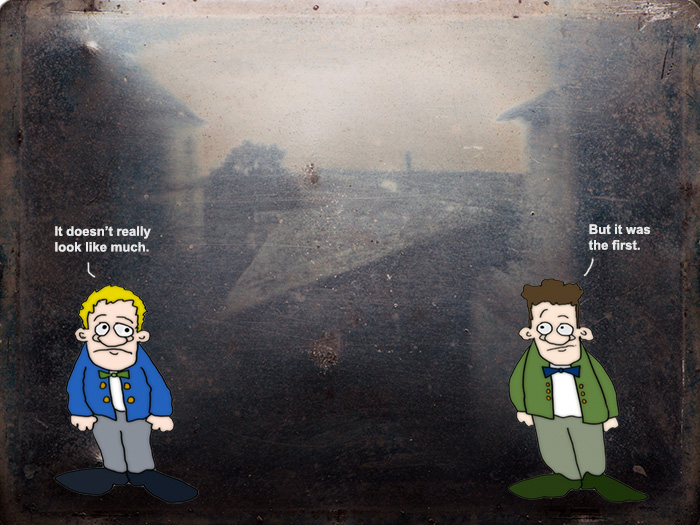This would be a day that would truly change all our lives.
It has to do with photography. Photography has changed so much over the years, along with everything else. But how about the very first photo?
It took centuries of advances in chemistry and optics to get to the first photograph. This included much exploration with the invention of the camera obscura. And all of this combined eventually led to the world’s first photograph. That happened in 1826. A French guy — a scientist named Joseph Nicéphore Niépce — made that photo.
He called it “View from the Window at Le Gras” because that is exactly what it is — a photograph taken at his family’s country home, a view of a courtyard and outbuildings. He shot it from one of the upstairs windows.
It took several hours. Several. He did it by exposing a bitumen-coated plate in a camera obscura on his windowsill. For a long time. The photo is grainy and barely readable, but it is the first one.
Okay, now jump ahead just 60 years. It was on today’s date, October 4, 1888, when George Eastman patented the first roll-film camera & registered “Kodak.”
Now. This, to me, was the day that truly changed photography for all the world. Truly.
Prior to this event, photography was a science, if you will. The equipment was highly expensive, the chemicals were volatile, and the process was tremendously long and arduous. And everything had to be precise for the photograph to be shot and developed correctly. Very few people owned and operated this equipment.
If you wanted your portrait taken, you would have to pay a photographer and sit for long periods, often wearing a neck brace to keep your head still. Over time, the process shortened slightly, but not much.
So when George Easement patented the first roll-film camera?
Photography became every person’s domain. It allowed people with moderate amounts of money to buy cameras and film. The process was fast to “snap” a photo. Or take a “shot.”
And processing was left to some lab that started mass-producing those rolls of film.
As you know, it has continued through the years, becoming more available and faster for every person on the planet. Now? Just reach in your pocket, and within a couple of seconds, your photograph can appear to people all over the world. Post it on Facebook, and over 3 billion people can see it instantly.
When I was a kid, my Mom had her camera — a roll-film Kodak — in her hand for every holiday, event, and happening in our family. From Christmas morning to scraped knees. Over the years, she amassed nearly 100 photo albums. I think there are 98 in all.
But we all groaned and moaned every time the camera came out. No one wanted to have their picture taken, but we all complied, and there we all are, forever preserved in those albums.
These days, as a society, we have gone from being camera shy to the world of 10,000 selfies. Everywhere you look, someone is pulling out their phones, turning them around, and capturing their moment at the McDonald’s, buying their first McFlurry of the season.
Thanks to George Eastman. A man who loved photography more than most. And now those cameras are everywhere. No more roll-film. But a digital infinity.
So smile, baby. You’re about to get shot.
==========
“A good snapshot keeps a moment from running away.”
― Eudora Welty
==========
“All photographs are memento mori. To take a photograph is to participate in another person’s (or thing’s) mortality, vulnerability, mutability. Precisely by slicing out this moment and freezing it, all photographs testify to time’s relentless melt.”
― Susan Sontag
===========
“To the complaint, ‘There are no people in these photographs,’ I respond, There are always two people: the photographer and the viewer.”
― Ansel Adams
============
First Photo. A long way we’ve come.
